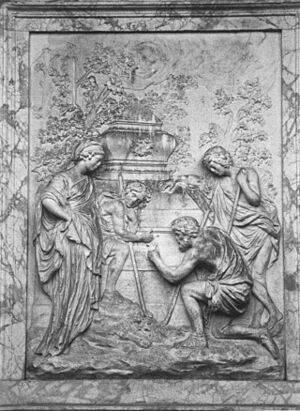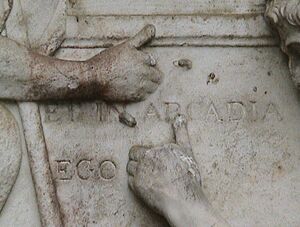Shugborough inscription facts for kids
The Shugborough Inscription is a mysterious set of letters carved on a stone monument in Shugborough Hall, England. This monument, called the Shepherd's Monument, was built in the 1700s. Below a carving that looks like a famous painting by Nicolas Poussin, you can see the letters O U O S V A V V, with D M below them.
No one has ever fully explained what these letters mean. It's often called one of the world's top unsolved ciphertexts, which are secret messages.
In 1982, a book called The Holy Blood and the Holy Grail talked about the monument. It suggested that the painting had secret meanings. Later, in 2003, Dan Brown's popular book The Da Vinci Code used ideas from The Holy Blood and the Holy Grail. Even though The Da Vinci Code didn't mention the Shugborough Inscription, it made people more interested in the older book and its mysteries.
In 2004, the Shugborough Estate worked with the Bletchley Park Museum (a famous place for code-breaking) to promote the inscription. They hinted that the monument might be connected to the Holy Grail, a legendary treasure. Many people offered their ideas, but no one found a clear answer.
Contents
The Mysterious Monument
The Shepherd's Monument was ordered by Thomas Anson and built between 1748 and 1756. It looks like a small building with two strong columns at the front. These columns hold up a decorated top part. This top part has carvings of laurel wreaths and two stone heads. One head shows a smiling bald man, and the other looks like Pan, a Greek god with goat horns.
Inside this structure, there's a curved arch. This arch frames a stone carving made by a sculptor named Peter Scheemakers. The carving is a copy of Nicolas Poussin's painting Et in arcadia ego. It shows a woman and three men, with two of the men pointing at a tomb. On the tomb, the Latin words Et in arcadia ego are carved. This phrase means "I am also in Arcadia" or "I am, even in Arcadia."
The carving on the monument is a bit different from the original painting. For example, it has an extra stone coffin placed on top of the main tomb. Below this carving, there's a stone plaque with the ten mysterious letters. Eight letters are on the first line, and two, D M, are on the second line, placed below the ends of the first line. The letters D M were often used on old Roman tombs. They stood for Dis Manibus, which means "dedicated to the spirits of the dead."
What Are the Theories About the Inscription?
Over the years, many people have tried to solve the mystery of the Shugborough Inscription. Even with all these ideas, the staff at Shugborough Hall are still not convinced by any of the solutions. In 2014, a spokesperson for the National Trust (who now own the property) said, "We get five or six people a week who believe they have solved the code, so we are a bit wary of them now."
Latin Initialism Theories
Some theories suggest the letters are an initialism (where each letter stands for the first letter of a word) for a Latin phrase.
- In 1951, Oliver Stonor thought the letters might be a secret message from George Anson to his dead wife. He suggested it stood for Optimae Uxoris Optimae Sororis Viduus Amantissimus Vovit Virtutibus. This means "Best of wives, Best of sisters, a most devoted Widower dedicates (this) to your virtues." A former code-breaker from Bletchley Park, Shiela Lawn, liked this idea. However, some people have pointed out that the Latin grammar in this phrase isn't quite right.
- Steve Regimbal believes the letters stand for a Latin translation of a Bible verse: "Vanity of vanities, saith the preacher; all is vanity." (from the book of Ecclesiastes). His Latin phrase is Orator Ut Omnia Sunt Vanitas Ait Vanitas Vanitatum.
- Keith Massey, a former NSA linguist, thinks the letters are an initialism for the Latin phrase Oro Ut Omnes Sequantur Viam Ad Veram Vitam. This means "I pray that all may follow the Way to True Life." He connects this to a Bible verse from John 14:6: "I am the Way, the Truth and the Life."
Code and Cypher Theories
Other ideas suggest the inscription is a type of code or cipher.
- Dave Ramsden (in 2014) suggested that the monument is like a tombstone for a special female figure called the "Shepherdess." He thinks the eight letters are a complex code used to hide the name "Magdalen."
- In his 2016 book Anson's Gold, George Edmunds proposed that the inscription is a code for the exact location (latitude and longitude) of an island. He believes Admiral George Anson, Thomas Anson's brother, buried Spanish treasure there. According to Edmunds, Anson received secret coded letters about this treasure.
English Initialism Theories
Some theories suggest the letters stand for words in English.
- Margaret, Countess of Lichfield (who lived from 1899 to 1988), thought the monument was a memorial built by Admiral Anson for his wife. She believed the inscription referred to a poem about a Shepherdess named Alicia. This Alicia lived on a hill in Rome and helped people become Christians. In this theory, the letters stand for the lines Out Your Own Sweet Vale, Alicia, Vanishes Vanity. Twixt Deity and Man Thou, Shepherdess, The Way. However, no one has ever found this poem.
- A. J. Morton noticed that some of the letters match the names of people who lived at Shugborough in the early 1800s. He thinks the inscription means Orgreave United with Overley and Shugborough, Viscount Anson Venables Vernon.
Images for kids
See also
 In Spanish: Inscripción de Shugborough para niños
In Spanish: Inscripción de Shugborough para niños






